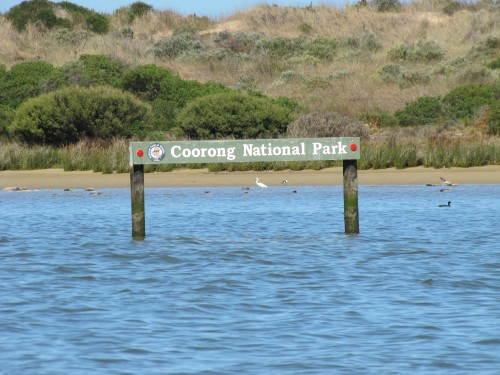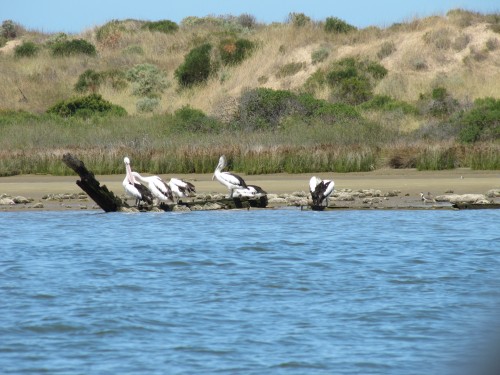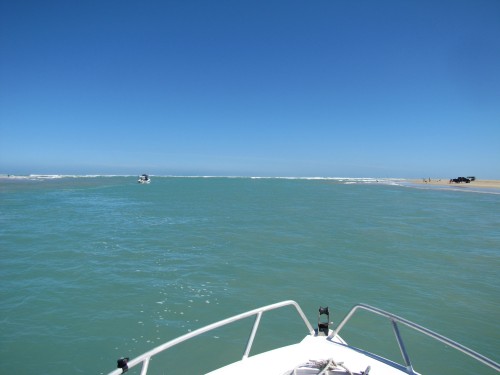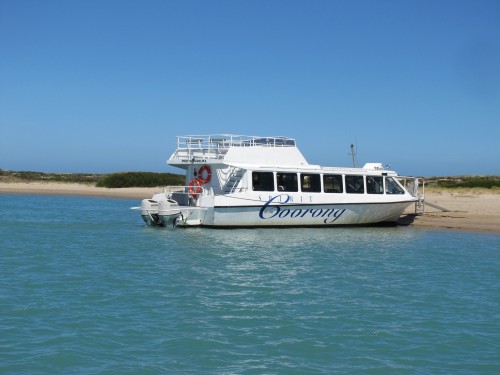Coorong National Park
On our recent boat trip we passed through the Goolwa barrages and headed south along the Coorong towards the mouth of the River Murray. It is here that Australia’s largest river empties into the Southern Ocean. As we travelled along we followed the line of sand hills which separate the Coorong from the ocean. It places these sand hills are spectacular – more of that for another post.
all along this stretch of the Coorong it is hard keeping up with all the birds one sees, especially seeing we were travelling most of the time at 25mph. On several occasions we had to slow down to slow walking pace and keep a sharp eye out for sand bars; more than once we almost became grounded.
In the photo above you can see a Little Egret, some Grey Teal and a Eurasian Coot just to the right of the sign.
Below the photo shows several Australian pelicans and a Masked Lapwing on the right. Almost impossible to see (except under extreme enlargement) are what look like Sharp-tailed Sandpipers and maybe a stilt.
A little further on we reached the mouth of the Murray. Our captain was unwilling to venture too close for fear of bottoming out on a sand bar. I was surprised by the number of vehicles on the beach and the number of people fishing along the shore of the river. I shouldn’t have been – it was a holiday long weekend and the weather was perfect.
The last photo below shows one of the tourist boats operating in this part of the river, The Spirit of the Coorong. It takes tourists from Goolwa down through the Coorong on a regular schedule.
Masked Lapwing flyover
I’ve just come inside after hanging out a load of washing. While this necessary task interrupts my writing, I do welcome and enjoy it. Firstly, it stretches my legs and gets me out of my chair and away from the computer for a few minutes. Then I enjoy the breath of fresh air. Finally, it allows me to be outdoors with my head up – always a good pose for birding.
This morning’s delight was two (a pair?) of Masked Lapwings (plovers) flying noisily just over my head. This is a very common species in this area, but strangely, we don’t often get them landing on our 5 acre block of land. They also don’t often seem to fly directly overhead either. We usually only hear them in the distance.
Last week on a visit to the nearby Monarto Zoo I photographed a Masked Lapwing sitting on a nest. In another enclosure we saw a pair escorting three young chicks. I hope they didn’t venture into the nearby cheetah enclosure!
Related article:
- Masked Lapwings -articles about lapwings from my archives.
Alexandra Gardens, Ararat, Victoria
On the last day of our holidays in January we travelled from Gisborne just north of Melbourne to home in Murray Bridge. It was a long day of driving and I had few opportunities for birding along the way. we left our friends’ place a little later than I had hoped so we didn’t stop for morning tea. We pushed through to Ararat for lunch.
In Ararat we found a reasonable spot in the Alexandra Gardens. Here I was able to do a few minutes of birding during and after our picnic lunch. On the lake were the usual types of birds one expects in lakes in parks and gardens: Eurasian Coots, Dusky Moorhens, Pacific Black Ducks and Silver Gulls.
While we were eating a flock of about 40 Long-billed Corellas came noisily wheeling overhead and settled in the tree above us. In the distance I saw a smaller flock of Yellow-tailed Black Cockatoos winging their way slowly across town. A Laughing Kookaburra called somewhere near and Masked Lapwings could be heard calling on the adjacent sports grounds.
In the shrubbery near us several Common Blackbirds gave their warning call as I came down the path, New Holland Honeyeaters were busy feeding in the well maintained Australian native plant section of the gardens and several Striated Pardalotes called from the canopy of the trees overhead.
Black Swans in an unusual place
My wife and I join a friend on a morning walk every weekday. On our way home we pass a small dam about half a kilometre from our home. This dam was constructed on a vacant block of land by our local council several years ago. It stores storm water from the nearby streets. Some areas near here have a flood mitigation problem only discovered about five years ago during an extremely heavy downpour one afternoon. The council workers pump water from this dam to use in watering street trees and to dampen road works where necessary.
I’ve kept an eye on this small reservoir ever since it first contained water. Generally all I see is a few Pacific Black Ducks, Straw-necked Ibis and a collection a Masked Lapwings (which have been seen breeding there). Welcome Swallows are also regular visitors, and I am sure the local population of White-winged Choughs use the wet mud on the edge of the water to construction their mud nests. One one occasion I also saw several Black-tailed Native-hens.
A few mornings ago I was surprised to see several Black Swans gracing the water. This species is not all that common around here, though I have seen several recently at the nearby Rocky Gully Wetlands, about three kilometres to the east.
One day I will get around to making a list of all the species I’ve seen in this dam.
And then I will need to find a way of encouraging the swans to fly over our land so I can count them on my garden list.
Do Blackbirds Swoop? How to Deal with Aggressive Bird Behaviour
Do Blackbirds Swoop?
This intriguing question was posted by Jill on one my earlier articles. I assured her in my reply that I have never heard of this species swooping humans.
You have nothing to fear where Common Blackbirds are concerned. I have never experienced swooping with this species. In fact, they are usually rather timid and will readily fly away from humans. I have checked on the internet and found no recorded instances of Common Blackbirds swooping humans.
I also read through the article on Common Blackbirds in HANZAB (Handbook of Australian New Zealand and Antarctic Birds Vol.7) and there is no mention of this behaviour. HANZAB is THE authority on Australian birds and is a compilation of all research done on birds in this region, including a comprehensive overview of all the relevant published literature on birds.
UPDATE: Since writing this article I have had many comments about Blackbirds swooping. Many have claimed that they do swoop. These comments have always come from American readers. I was writing about the Common Blackbird, an introduced species in Australia. They come from Europe and are not related to several species found in America which do swoop. The Red-winged Blackbird of north and central America is very aggressive I believe. Some readers may also have been confused by my comments, thinking I was talking about the Grackle.
Magpies and Lapwings
Most Australians know about the problem with Australian Magpies and swooping. They need to be given a wide berth when nesting. What many people do not know is that Masked Lapwings (also called Spur Winged Plovers) can inflict a nasty wound. Keep away from their nests or young is the message they are giving. On most occasions their attack is 95% bluff and injuries are rare. Last spring there was a very unusual news report on television showing footage of Magpie Larks attacking humans near the Festival Centre in the CBD of Adelaide. This is the only occasion I have known of this species swooping like their bigger cousins.
Kookaburras and Butcherbirds
Other species that may occasionally swoop include Kookaburras (one individual once took a sausage from a barbecue I was cooking). I once had an opportunistic Grey Butcherbird snatch a sandwich from my hand while on a picnic. In both these cases they were swooping for food – not attacking me. Gave me a fright though.
Geese, Ducks and Swans
In parks and gardens as well as zoos and wildlife parks, any of the species of geese can get a little aggressive. This is often as a result of too many people feeding them. Many species of ducks can also get this way. I’ve even known Black Swans to act aggressively. In most cases they are after food; they are not intending to harm people.
Pelicans
I have heard of an instance of an Australian Pelican eating a small dog on the riverfront at Renmark in South Australia. I’m not sure if this is a true story or an urban myth, but pelicans would be quite capable of this. What I have witnessed was rather scary. We had visited the bakery at Mannum and were sitting on a seat near the riverfront eating our lunch. A pelican came up to us and almost snatched a sausage roll from the hand of my daughter-in-law. Having a pelican a metre away staring you directly in the eye is very unnerving.
Emus and Cassowaries
Many years ago while visiting a zoo in the SW of Western Australia I had another unnerving encounter, this time with an Emu. I was in a walk through enclosure containing ducks, geese, emus and kangaroos. One Emu took a liking to my camera lens and my glasses. Being followed by an Emu – no – harassed is a better word – was distressing, especially as the said Emu constantly tried to peck either my glasses or the camera lens. I was so constantly under attack that I had to quickly leave the enclosure, much to the amusement of my family!
The Southern Cassowary of northern Queensland has a reputation for being aggressive towards humans. I don’t have personal experience of this species, but I know that when I do visit that region, I’m going to be wary of the cassowary!
Ibises and Gulls
Gulls and picnics seem to go together. Especially when you produce some fish and chips. It is as if you’ve put up a huge neon sign saying “Come to the feast.” Again, this is as a result of feeding by humans and not a direct attack to harm. Having said that, it is intimidating and annoying to have a Silver Gull standing on your picnic table 30cm away from your lovely chips. In some parts of Australia, Ibises are a major problem too, snatching food from children in particular. Our larger Ibis species are almost as large as a toddler learning to walk. Scary stuff for a youngster.
Willie Wagtail
Willie Wagtails are generally loved by all Australians and is one of our most recognisable birds. What most people do not realise is that these endearing little creatures can be very bold and aggressive when there are babies in a nest nearby. Our resident Willie Wagtails have given us a little tweak on the head if we venture too close to the nest. And they are not too slow to attack birds much bigger than themselves; even our largest eagle, the Wedge Tail, is not immune from harassment.
Honeyeaters
Honeyeaters are not known for their aggression towards humans. If you get too close to their nest they will let you know, scalding you incessantly from a nearby branch. However, they can be very bold. Many years ago a friend in Port Augusta related to me an occasion when a honeyeater landed on his shoulder and tried to pluck a hair from his rather ample beard. While this incident is not a display of aggression, it does show how courageous they can be.
Eagles
There have been a few recorded instances of people being attacked by eagles, hawks and other raptors. Only last year I was aggressively swooped by what I think was a Brown Falcon. I can’t be sure because I didn’t hang around too long. I was invading his territory so I beat a hasty retreat. He didn’t contact any part of me but it was a little unnerving.
How to Deal With Aggressive Bird Behaviour
- Give the birds space – keep away from their nest or their young. Think about how you would react if a large monster invaded your home. They are protecting their offspring so respect their space. If there is a magpie nesting on your usual walking route, try to take an alternative route until the nesting has finished.
- Wear protective clothing – this is particularly so with swooping magpies. Wear a hat or helmet to avoid injury. Some people say that painting large eyes on the back of a helmet, hat or cap helps to deter magpies from swooping.
- Don’t feed native birds – if everyone followed this rule there wouldn’t be a problem but it is probably too late for that. If you are having a picnic, don’t be tempted to throw food scraps to the gulls of ducks or whatever is nearby. Just one chip or bread crumb thrown at one bird will often result in dozens of birds flocking to your picnic ready for a handout. In the case of Gulls, it could result in hundreds surrounding your picnic spot.
- Carry a stick – I’ve proved this to be effective with magpies swooping. Carry a stick above one’s head as you walk through a magpie nesting zone. This deters them from attacking your head. Decorating the stick with ribbons can add to the distraction level.
- Carry a flag – this one is mainly for cyclists. Mount a pole on your bike with a flag at the top. It will help motorists see you too!
Readers’ Contributions:
I invite readers to leave their comments about their experiences with aggressive birds.
- Which birds have swooped you?
- How have you been harmed by birds?
- What about birds in other countries? Do they swoop or attack?
- What solutions to aggressive bird behaviour can you share with readers of this blog?
UPDATE:
- Readers on this blog have contributed many interesting comments – click on the comments section below this post.
- I have written a followup article called A Bit on the Nose. This post quotes in full an amusing email sent to the the Birding-Aus forum today. Special thanks to Bill for permission to quote the email in full.
Related articles and links:
- Common Blackbirds – my article that started me on this post.
- ProBlogger – this article has been submitted to the Group Writing Project “How to…” being run by Darren Rowse on ProBlogger.














